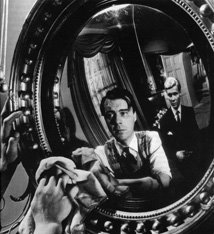

After seeing Harold Pinter's The Caretaker, Joseph Losey wrote to him saying how much he had liked it. Pinter replied with thanks, and asked for work... Thus was born the working relationship which would lead to three collaborations, The Servant (1963), Accident (1967) and The Go-between (1970).
The Servant begins by playing out the master and servant power relationship between Dirk Bogard (as manservant Hugo) and James Fox (as pseudo-aristo Mr Tony) and is taken from the Robin Maugham novel of the same name. Pinter inflects the dialogue with his trademark repetitions, terse dialogue and menacing undertones. But the film belongs to Losey with his visual and sonic style maturing into an exceptional exploration of confined space: mirrors, staircases, shadows, long takes, strange angles, dripping taps, chiming clocks and intruding exterior soundscapes...
The film was lauded by critics and the public alike... and theorists have tended to focus upon the seeming reversal of the roles of Hugo and Tony as the film progresses. However, there is no simple reversal but rather an endless tug of war back and forth between Hugo, Tony and the women in their lives, Vera and Susan... this film then, rather than a manifesto for class war or socialist/communist ethics, explores power itself and in this way seems to sit more within the framework of Michel Foucault than Marx and Engels.
Labels: British Cinema, David Deamer, Joseph Losey, The Servant



2 Comments:
This film was an experience. I laughed quite hard in places over the extremely (in my opinion) homoerotic content. Admittedly, more because Dave had said that everyone involved with the film had vigorously denied that aspect of it. Quite how they could with a straight face is beyond me seeing as sometimes it felt like a gay carry-on film (double entendre anyone?). I mean seriously, how can you mention ‘manservant’ that many times in a sentence?
As with The Sleeping Tiger, The Servant was consummately filmed. The more I see of Losey’s work, the more deeply I love. He is completely out to upset notions of how things should move on film, in terms of his characters, his sets, and his cameras. The viewing experience is a constant revelation almost dizzying in its fluid intensity.
Some brilliant moments. The dripping tap. The normally underestimated background tracks (the sound techs must have had a blast). My personal favourite is the scene in a train station where we are suddenly introduced a series of characters we will never see again during the rest of the film and the conversation of the protagonists is woven into the personal dramas of the intruders. Sublime. Another interesting thing Dave mentioned in the intro was that this was a last minute request, something Losey asked Pinter to include after it had been written and was in production.
Once again, superb film. I think I liked it even better than The Sleeping Tiger. A mean feat.
Vee
Visually intricate: In “The Servant”, Losey opens up the screen past its constructed limits.
In the same way as we saw 2 weeks ago in “Sleeping Tiger” Joe Losey has again opened up the limits of the viewable in the screen but this time in a more architectural way, constructing scenes that hold a 3D space that is more than a conventional 4:6 screen.
The camera negotiates the space with ease and in a seemingly recurring theme mirrors are used to show what would normally be out of shot, creating a frame within a frame, not showing 2 events but used to open up the screen to build on character interaction.
It seems to be a more developed play with shape and space in “The Servant”, in shots that are viewed through a glass orb to open up the camera shot to almost incorporate the entire room, in distorted view. Joe has developed a cinematic style that creates a cinematic eye within the frame.
Post a Comment
<< Home